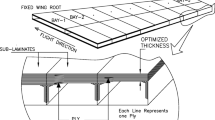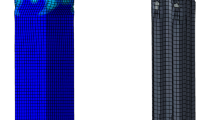Abstract
At the present situation composite material, particularly laminate type systems are becoming increasingly important in civil aviation due to their strength and weight characteristics. However, the effectiveness of these materials depends on the rational usage of its mechanical properties. There is an optimal fiber angle in the case of ply stacking and optimal ply thickness. Both manipulations reveal the variability of composite features. This work is carried out about the optimization of aircraft structure elements. Optimization issues will cover both constituents. The process will be dividing into stages, and the most factors affecting the final result will be considered with a sight to the two main criteria (strength and weight). Using the structure diagram scheme of a vertical stabilizer, an analysis was carried out and an algorithm was developed that allows finding optimum in the structure depending on the specific loads. The optimization issues have been laid by ply stacking and thickness. Complex analysis and algorithm simplicity of the program code makes it possible to use the advantages of composite materials which showed significant weight superiority in comparison with metal analogues.









Similar content being viewed by others
References
Stark J (2011) Product lifecycle management. Springer-Verlag, London
Chawla Krishan K (2012) Composite materials. Springer-Verlag, New York
Megson THG (2017) Aircraft structures for engineering students, 6th edn. Elsevier, Amsterdam
Gibson RF (2016) Principles of composite material mechanics, 4th edn. CRC Press, Boca Roton
Burden RL, Faires DJ, Burden AM (2015) Numerical analysis, 10th edn. Cengage Learning, Boston
Kincaid DR, Cheney EW (2002) Numerical Analysis: mathematics of scientific computing, 3rd edn. American Mathematical Society, Providence
Fung YC, Tong P, Chen X (2017) Classical and computational solid mechanics, 2nd edn. World Scientific, Singapore
Dudchenko AA (2002) Optimal design of the aviation structure from composite material. MAI publisher, Moscow (In Russian)
Timoshenko S (2004) Strength of materials, 3rd edn. CBS, New Delhi
Rowland R Jr (2001) Principles of solid mechanics. CRC Press, Boca Roton
Sun CT (1998) Mechanics of aircraft structures, 1st edn. Wiley, Hoboken
Timoshenko SP (1983) History of Strength of Materials. Dover Civil and Mechanical Engineering. Dover Publications, New York
Zhitomirsky GI (1995) Aircraft structure, 2nd edn. MAI publisher, Moscow
Ye Jianqiao (2003) Laminated composite plates and shells. Springer-Verlag, London
Kalechman M (2008) Practical MATLAB basic for engineers. CRC Press, Boca Roton
Lindfield G, Penny J (2018) Numerical methods, 4th edn. Elsevier, Amsterdam
Martinez WL, Martinez AR, Solka J (2017) Exploratory data analysis with MATLAB. CRC Press, Boca Roton
Sierakowski RL, Newaz GM (1995) Damage tolerance in advanced composites. CRC Press, Boca Roton
Jawaid M, Thariq M, Saba N (2018) Structural health monitoring of biocomposites, fibre-reinforced composites and hybrid composites, 1st edn. Elsevier, Amsterdam
Author information
Authors and Affiliations
Corresponding author
Rights and permissions
About this article
Cite this article
Erik, T., Yin, Y. Optimization of vertical stabilizer structure diagram. AS 3, 97–105 (2020). https://doi.org/10.1007/s42401-020-00051-0
Received:
Revised:
Accepted:
Published:
Issue Date:
DOI: https://doi.org/10.1007/s42401-020-00051-0




